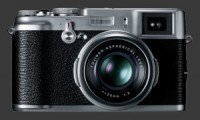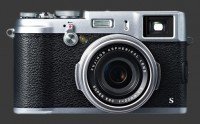Fujifilm X100S Review
Fujifilm X100S Usability - How easy is it to use?
This page is nearly identical to the usability page of the X100 review
Fujifilm Finepix X100 since these cameras are nearly identical. Changes are highlighted below in green.
The Fuji X100S is styled along the lines of a film rangefinder which has a lot of implications on its usability and ergonomics. How much the X100S's ergonomics get appreciated depends greatly on the basis for comparison and nostalgia. Never having used a film rangefinder, we will not be swayed in this review by the latter!

Starting with ergonomics, the X100S is rather boxy. It has a slight bump as a grip which provides almost no purchase. What adds security though is that its design requires both hands to operate. The shutter-release on the top-plate is usable but certainly not as comfortable as modern cameras that mount it on a slant. At the rear, the thumb naturally falls on the rocker. With practice, you can get used to placing it over the small empty area just below. Most buttons at the rear-right are within reasonable reach of the thumb while holding the camera.
Along the left edge of the camera there is a column of seldom-used buttons. This is fortunate since the left hand is normally underneath the camera to reach the lens barrel. The lens protrudes less than 1" from the camera which keeps the whole package small. The downside is that having both a focus and aperture-ring around is tight. Fuji placed small tabs on opposite sides of the lens to make it easier to turn but friction from the front of the camera while turning the ring never feels completely comfortable.
What feels extremely comfortable on the left-side of the camera is the viewfinder. The Fuji X100S is extremely comfortable to hold at eye-level and you can bring your eye very close to it without pressing your nose against it. Strangely, many cameras have done the opposite lately, moving the LCD to the left edge which makes smudge marks even more troubling. Kudos to Fuji for moving the right thing to the left!
The X100S clearly has more direct controls than the vast majority of fixed-lens cameras. It is also highly modal, meaning that most dials have marked positions. This makes the camera state readable by simply looking at the camera, even when off. This design makes the X100S more efficient to use than the majority of compacts but not as much as advanced mirrorless cameras and DSLRs because of a number of oddities explained below.

The aperture ring around the lens is labeled with full-stops from F/2 to F/16, plus an automatic settings. This makes it ultra-quick to set aperture in full-stops. However, to set the aperture between stops, which is possible in 1/3 increments, the rocker under your thumb must be used. This means that two controls are required to set aperture precisely, making is slower and more fiddly than using a typical control-dial.
Setting shutter-speeds is even more complex. Once again, there is a dial which sets full-stop increments from 1/4000s to 1/4s. For selecting shutter-speeds between stops, which is also only possible in 1/3 increments, a very thin dial around the 4-way controller is required. With it, you can adjust shutter-speed by ±2/3. Even slower shutter-speeds use the T position and then the rear dial can select shutter-speeds down to 30s. Bizarrely, even impossible shutter-speeds can be set. When selecting 1/4000s, for example, at an aperture wider than F/8, the speed lights up red on the display. The B position is for Bulb mode which works just as expected except when the aperture ring is at the A position, in which case the camera always exposes for 30s at F/16.
Despite having 4 controls to set 2 parameters, as described, there is no direct control for ISO, which one would expect from the only camera with 3 control-dials! With the Function button set to ISO, pressing it when not using the OVF makes the ISO menu appear which can be scrolled with the rear dial or the Up and Down buttons of the 4-way controller. Otherwise, using the menu is required which slows things down. While using the OVF, a press of the Function button, when assigned to ISO, allows the rocker switch to select the ISO.
The last dial on the X100S is for Exposure-Compensation. It works universally and is completely predictable. Its state is reflected on a scale in the viewfinder. Steps are marked, so only 1/3 increments are available.
Absent from the Fuji X100S is an exposure mode-dial. With this camera, like the analog ones that inspired it, a photographer does not announce in advance which exposure parameters can be set. Instead, parameters are simply set to the desired value. If a parameter should be automatically controlled, then it is simply set to the A position. With two dials, this gives access to the four standard PASM mode:
| Exposure Mode | Aperture Ring | Shutter-Speed Dial |
|---|---|---|
| Program | A | A |
| Aperture-Priority | F/2 - F/16 | A |
| Shutter-Priority | A | 1/4000 - 1/4, T |
| Manual | F/2 - F/16 | 1/4000 - 1/4, T, B |
Focus modes are set using a slider on the left side of the camera. It is small and flush, so one can accidentally pass the middle setting easily. The bottom position if AF-S, while the top is MF. To set focus manually, a fly-by-wire ring at the front of the lens-barrel is used.
While the ring is physically the same as on the X100, its action has been immensely improved for the X100S. It responds quickly and adjusts focus with a reasonable throw. The EVF is now sufficiently precise to see what is in focus even without magnification. Pressing the rocker inwards brings up MF-Assist which makes MF easy.

The LCD on the rear has 460K pixels and measures 2.8" diagonally with a 4:3 aspect-ratio. It is bright with good visibility and viewing-angle. It has a good refresh rate and an excellent anti-reflection coating. The preview sadly always shows the metered exposure plus EC rather than the actual. The live-histogram unfortunately reflects it too, so this camera is not Exposure-Priority. Still, when the actual exposure coincides with the metered one, the preview is roughly correct.
The unique hybrid viewfinder is a neat achievement. It combines an optical-tunnel viewfinder with an electronic one in the same space. In optical mode, the electronic components show an amazing HUD. Just like a typical optical-tunnel, the OVF shows neither focus, nor exposure, nor framing accurately. Framing is completely inaccurate. The view through the OVF shows considerable more than 100% while a frame within it supposedly marks a 90% coverage boundary. Because of alignment differences between the lens and OVF, the inner frame shifts after focusing, so reframing may be required. In practice, it does not shift enough so elements within the 90% boundary can still be chopped when the image is taken. Even after weeks of practice, accurately framing with the OVF is impossible.
The EVF is excellent. It is sharp, bright and refreshes quickly. Coverage is 100% accurate. It also previews color and white-balance well. Like the LCD, it is not exposure-priority but shows the metered exposure including EC instead. Within the exposure-range of the camera, it can be used to predict exposure and choose how much EC to apply. Here too, the live-histogram is based on the display.
An Eye-Start sensor switches very quickly between the viewfinder and rear LCD. This avoids having to manually switch between the displays. In OVF mode, the switch is instant while in EVF mode there is a small unfortunate delay while the camera opens and closes the finder window.

The bottom of the X100S has a metal tripod mount which is neither inline with the lens nor the center of the camera. This is also where the combined battery and memory compartment is located. The battery is almost symmetric which lets it be inserted the wrong way.
Despite a number of usability issues, the X100S remains faster to operate than most compacts. It also features an APS-C sensor which gives it much more control over depth-of-field than other fixed-lens cameras, more so when considering the bright F/2 maximum aperture of its lens. In use, the EVF rules, providing a stable eye-level way to frame accurately. Compared to a DSLR, the freedom afforded by the X100S's size is tremendous, not just for the shooter but also for subjects who can feel more comfortable being photograph by a small camera.
 |
Please Support Neocamera
All information on Neocamera is provided free of charge yet running this website is a huge endeavor. Purchases made via affiliate links found throughout the site help keep it running and up-to-date. There is no additional cost to you, so please consider buying via these links to our affilates:
Thank you for your support!
Fujifilm X100S Highlights

Sensor-Size: 24 x 16mm

Actual size when viewed at 100 DPI
| 16 Megapixels Fixed Lens | ISO 200-25600 |
| Fixed 35mm lens | Shutter 1/4000-30s |
| 0.48" Hybrid EVF 2.4 Megapixels (0.50X) | Full manual controls, including Manual Focus |
| Automatic Eye-Start sensor | Custom white-balance with 2 axis fine-tuning |
| 1 Axis Digital Level | Spot-Metering |
| 6 FPS Drive, 29 Images | Hot-Shoe |
| 1920x1080 @ 60 FPS Video Recording | Stereo audio input |
| 2.8" LCD 460K Pixels | Lithium-Ion Battery |
| Secure Digital Extended Capacity |
Updates
2025.11.13

Best Gifts for Photographers in 2025 by Budget
The annual Neocamera Photography Gift Guide updated to 2025. Find great gifts for photographers with any price budget.
2025.07.07

Stellar Photo Recovery Review
Review of Stellar Photo Recovery V12. This Windows and MacOS software can recover photos and videos in a huge number of formats from memory cards, USB drives, SSDs and HHDs.
2025.05.14

Huion Kamvas 13 Gen 3 Review
In-Depth review of the Huion Kamvas 13 Gen 3 Pen Display Tablet for photographers and graphic artists.
2025.01.18

Fujifilm GFX 2025 Lens Roundup
Lens Review roundup of Fujifilm GFX Medium-Format lenses. Quality, performance and handling of the GF20-35mm F/4R WR, GF30mm F/3.5 Tilt-Shift and the GF55mm F/1.7.
2024.11.18

Best 2024 Photography Gifts for Every Budget
Great gifts for photographers and photo enthusiasts selected for every budget among the best products of 2024.
2024.08.07

Eye Protection Tips for Professional Photographers
The four main considerations for professional photographers regarding eyewear.
2024.07.14

Fujifilm X100VI Review
Flagship fixed-lens compact digital camera with a 40 MP sensor and Image-Stabilization, a first for the series. Retro design featuring dual control-dials, plus direct ISO, Shutter-Speed and EC dials. Its hybrid viewfinder can switch between EVF and OVF mode.
2024.05.09

Fujifilm GFX100 II Review
Flagship 102 Megapixels Medium-Format Mirrorless Digital Camera with 8-Stop 5-Axis IBIS, 8 FPS Drive, 8K Video and 400 MP Super-Resolution capture in a weatherproof and freezeproof body with dual control-dials and dual memory-card slots.
2024.04.03

Fujifilm X-T5 Review
Newest Fujifilm flagship boasting a 40 MP APS-C sensor, 5-axis IBIS with 7-stop efficiency, 15 FPS continuous drive, 6.2K Video capture, dual control-dials and dual SDXC UHS-II slots in a sturdy weatherproof and freezeproof body.
2023.11.20

Best Digital Cameras of 2023
Find out which are the Best Digital Cameras of 2023. All the new Mirrorless Digital Cameras from entry-level to high-end professional.
2023.07.10

Fujifilm X-H2 Review
40 Megapixels APS-C Hybrid Mirrorless Digital Camera with 7-stop IBIS. Fastest shutter ever and 8K video capture. Large builtin EVF with 0.8X magnification and 5.8 MP, plus an Eye-Start Sensor. Packed with features and large number of controls in a weatherproof and freezeproof body.
2023.05.07

Sony FE 20-70mm F/4G Review
Review of the unique Sony FE 20-70mm F/4G lens. The optical zoom of this lens spans ultra-wide-angle and medium focal-length coverage, making it one of the most versatile Full-Frame lenses on the market.











